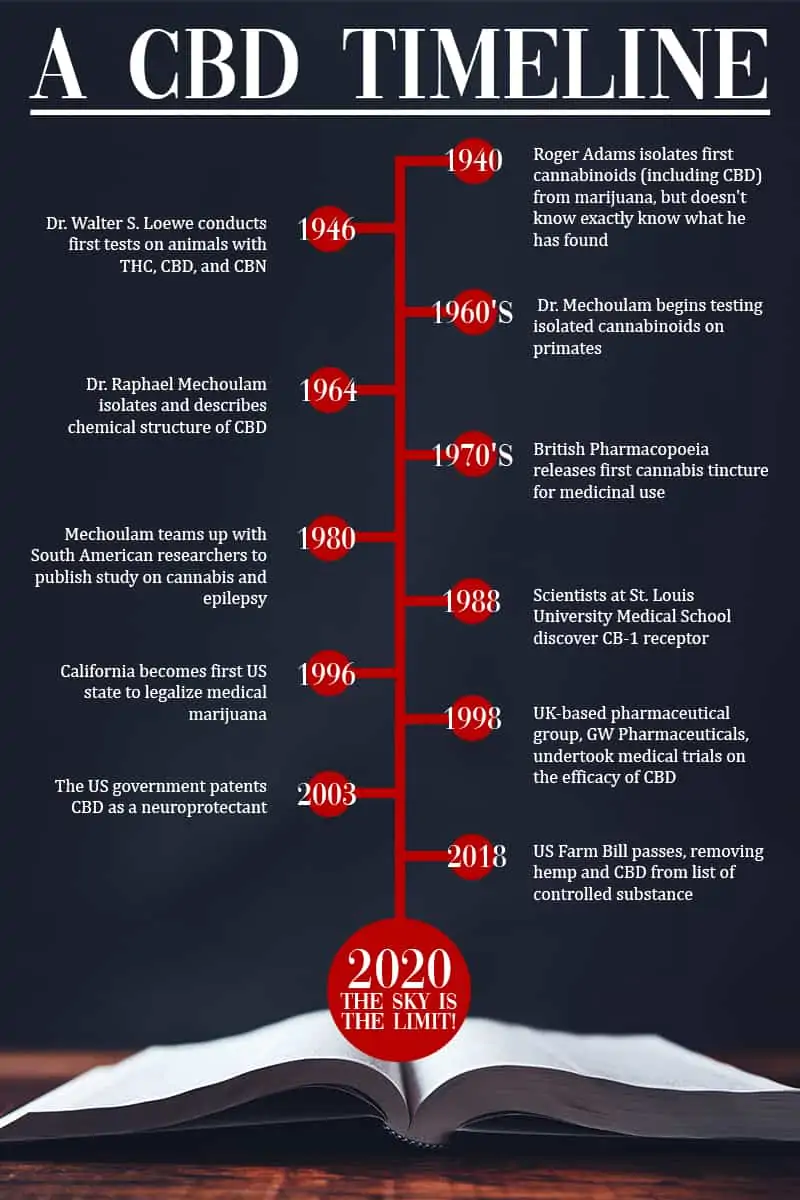CBD Oil News
CBD History: When Was CBD Discovered?
Did you know that the first recorded use of cannabis for medicine was back in 2737 BC? Yes, cannabis history is long! We know what it was used for, where, and how, dating back thousands of years. It’s seriously super impressive.
But what about CBD history? Can we claim the same for our non-intoxicating friend? Nope. As far as CBD goes, it’s all pretty new – not even a century old yet!
That doesn’t mean it’s any less interesting though!
Let’s jump in the phone booth and head back in time.
CBD History: The Beginning
CBD history all begins in 1940, when British Chemist Robert S. Cahn reports the partial structure of the first individual cannabinoid, cannabinol (CBN).
Then, 2 years later, across the pond, American chemist Roger Adams leaves his lab and announces the successful isolation of Cannabidiol (CBD). Adams isn’t done – he also discovers Tetrahydrocannabinol (THC)!
Yes, you read that correctly – CBD was actually discovered before THC!
By 1946, Dr. Walter S. Loewe is testing these 3 cannabinoids for the first time on animals. He notices that CBD and THC seem to have very different effects on the behavior of mice… interesting… (oh, the magic of hindsight).
[RELATED] The history of hemp in general is just as fascinating. Check this out next.
When was CBD Discovered?
So why, if several people have been involved in the “discovery” of CBD so far, do we attribute that discovery to someone else?
Well, the thing is, although Adams isolated CBD, he wasn’t exactly sure what he’d found…
It wasn’t until 1963 that Dr. Raphael Mechoulam describes the chemical structure of CBD for the first time. This is a major breakthroug in helping to understand the effects of individual cannabinoids. His work a year later in discovering the chemical structure of THC would help explain that earlier disparity Adams noticed with the behavior of mice.
This breakthrough research is probably why Mechoulam’s known as the “Father of CBD.”
By the 1960s, Dr. Mechoulam begins testing isolated cannabinoids on primates, and by the 1970s, the British Pharmacopoeia releases the first ever cannabis tincture for medicinal use.
Then, in 1978, the first major life-changing study hits the shelves (well, not literally the shelves, but you get what I’m saying). Mechoulam teams up with South American researchers to publish a groundbreaking study on cannabis and epilepsy. This study, entitled Toward Drugs Derived from Cannabis, looked in depth at the potential application of CBD when it comes to the treatment of epilepsy.

Movements Towards Legality
At this point in CBD history, although research is making great strides, it’s still living under that cloud of previous prohibition. The 1937 Marijuana Tax Act saw hemp decline rapidly in the United States. Then, in 1970, The Controlled Substances Act classified hemp as an illegal Schedule I drug.
In order for further inroads, that needs to change. And it does, starting in 1996 when California becomes the first US state to legalize medical marijuana. Oh, we’re not quite there yet… but research around the word continues.
In 1998, UK-based pharmaceutical group, GW Pharmaceuticals, begins medical trials on the efficacy of CBD. Then, in 2003, the US government patents CBD as a neuroprotectant. That’s huge!
And then… in 2007, the first hemp licenses in over 50 years are granted to two North Dakota farmers. We’re off and running.
CBD History: The Impact of the Farm Bill
Most of us know that CBD is legal now in the United States thanks to the Farm Bill. So how did it get going?
- 2014 – President Obama signs the Farm Bill, which allows research institutions to start piloting hemp farming.
- 2015 – The Industrial Hemp Farming Act is first introduced in the House and Senate. This act is the first of several attempts to fully legalize hemp.
- 2018 – After failed attempts to pass hemp-specific laws, an amendment to the Agricultural Improvement of 2018 (the “Farm Bill”) legalizes hemp in the US. This amendment removes the hemp plant, along with any of its seeds and derivatives (including CBD), from the Controlled Substances Act.
Since this monumental change, research into CBD has skyrocketed. Government funding has increased, and several accredited institutions have begun intense studies into the benefits of CBD!
So what’s next for the CBD history books? Only time will tell, but from where I’m sitting, the future looks pretty grand!

